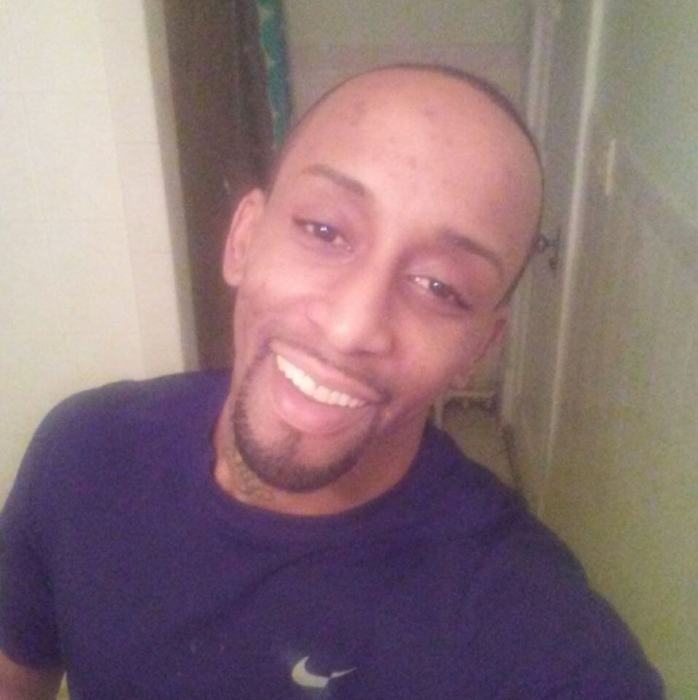George Bellinger, Jr., Patrick A. Sands, and Jack Russell in the Bronx. | GAY CITY NEWS
As he was headed to criminal court in Manhattan roughly seven years ago, Patrick A. Sands was dressed in a suit with a pink tie. He was handcuffed to another defendant who objected, calling Sands a “faggot” and a “mook.” The other man then punched Sands.
In another incident, Sands was waiting in a cell with another well-dressed defendant. Other defendants ordered them to “sit like a dog or we’re going to cut you.” A corrections officer passed by and took no action.
“I vowed from that day forward that I would do something,” said the 30-year-old Sands. And so he has.
In late 2011, he incorporated Sands’ House, named for his grandmother, with the goal of eventually building a residence that will house lesbian, gay, bisexual, and transgender offenders after they leave prison. The group will also advocate for queers who are incarcerated and train corrections officers, staff at agencies that serve offenders, and others.
“If COs walk by and do nothing, then that’s the culture and we have to change the culture,” said George Bellinger, Jr., who is consulting on Sands’ House and has a long history of working with non-profits.
At present, Sands’ House is more of a plan than a reality. Sands, the founder and chief executive officer, is working out of the Bronx headquarters of the Osborne Association, a non-profit that works with offenders and is the Sands’ House fiscal sponsor. He has five people on his board, including two Osborne Association staffers.
Sands’ House has a $50,000 start up grant from Henry van Ameringen, the gay philanthropist, and he received assistance on questions regarding incorporation of the non-profit from Thomas Duane, the openly gay state senator who represents Chelsea. He has one staffer, Jack Russell, a straight 24-year-old program assistant, who is earning a stipend.
“He really put his all into it,” Russell said of Sands. “It’s not a job for him, it’s a life for him.”
Sands is not drawing a salary. He noted that he is behind on his rent, but was able to convince his landlord that his vision for Sands’ House is worth supporting.
“I left my job, full-time job paying $40,000 a year, to nothing,” Sands said. This is not an academic exercise for him. He was sentenced to six years in prison in 2005 and got an early release.
“Some time ago, when I was younger, I got into trouble,” he said. “I ended up going to state prison.”
Prison was difficult for Sands, as it is for many queer inmates, and it was his fellow detainees who were the issue.
“The inmates are the biggest problem for LGBT people,” Sands said. “Transgenders have it the worst.”
Sexual assaults of queer inmates are a serious problem in prisons. The 2008 National Former Prisoner Survey of state inmates found that 39 percent of gay male inmates reported having been sexually assaulted by another inmate, and 12 percent said prison staff assaulted them; 34 percent of the male bisexual inmates reported sexual assaults by inmates, and 18 percent said they victimized by staff; and 18 percent of bisexual female inmates said they had been assaulted as did 13 percent of lesbian inmates. Reported assaults by male and female heterosexual inmates ranged from single digits to 13 percent.
Sands’ problems did not end when he left prison. He had no job and no place to live. He felt that the reentry programs he joined did not speak to him as a gay man.
“I came home to a hostile environment,” he said. “I was left to the street… Why would I want to sit in a group of people that can’t understand me?”
For Sands, an immediate challenge is identifying clients –– the program already has five –– and the size of the population it will serve. The city and state corrections departments do not ask about the sexual orientation or gender identity of inmates at intake, though Sands would like them to, and there are no estimates of how many inmates in New York are gay, lesbian, bisexual, or transgender.
“The Department of Correction has never dealt with the LGBT issue, state or city,” Sands said.
The state corrections department currently has 56 inmates who have a gender identity disorder diagnosis and are receiving hormone therapy. The state has 56,000 offenders in custody.
There are queers behind bars. A 2010 study published in the American Journal of Criminal Justice of 499 male and 436 females inmates in a “large Southern state prison system” found that 20 percent identified as gay, lesbian, or bisexual. The questionnaire was self-administered, so it is likely that the 20 percent figure is inflated by more queer inmates choosing to participate.
Asking an LGBT prisoner to reveal themselves to corrections officials could create problems.
“I don’t trust them, but we have to look at the system as a whole,” Sands said, but he needs that data. Sands’ House is part of a coalition that is trying to gather this information.
“What I plan to do is get data,” he said. “The purpose of the coalition is to collect data.”
Sands’ House will be the place where these inmates come to find the “love, forgiveness” that Sands’ grandmother showed him.
“I believe that Sands’ House is where they come to get healed,” Sands said. “The work starts in prison and then we work with you all the way through.”

































